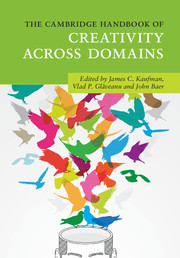Book contents
- The Cambridge Handbook of Creativity Across Domains
- The Cambridge Handbook of Creativity Across Domains
- Copyright page
- Dedication
- Contents
- Figures
- Tables
- Contributors
- Acknowledgments
- Part I Creativity and Domain
- 1 Creativity Across Different Domains
- 2 The Amusement Park Theoretical Model of Creativity
- 3 Mix and Match
- 4 Domain-General Creativity
- Part II Creativity in the Traditional Arts
- Part III Creativity in the Sciences
- Part IV Creativity in Business
- Part V Newer Domains for Creativity Research
- Part VI Creativity in Everyday Life
- Part VII Conclusion
- Index
- References
3 - Mix and Match
Opportunities, Conditions, and Limitations of Cross-Domain Creativity
from Part I - Creativity and Domain
Published online by Cambridge University Press: 15 September 2017
- The Cambridge Handbook of Creativity Across Domains
- The Cambridge Handbook of Creativity Across Domains
- Copyright page
- Dedication
- Contents
- Figures
- Tables
- Contributors
- Acknowledgments
- Part I Creativity and Domain
- 1 Creativity Across Different Domains
- 2 The Amusement Park Theoretical Model of Creativity
- 3 Mix and Match
- 4 Domain-General Creativity
- Part II Creativity in the Traditional Arts
- Part III Creativity in the Sciences
- Part IV Creativity in Business
- Part V Newer Domains for Creativity Research
- Part VI Creativity in Everyday Life
- Part VII Conclusion
- Index
- References
Summary
Is it possible to be creatively successful in many domains? In this chapter, we explore this question and discuss potential mechanisms of cross-domain creativity (CDC). To this end, we start with defining CDC, present its hypothetical trajectories in development, and explore the role of domain-general creative potential for CDC. We pay special attention to a creative self-concept as an important factor shaping creative activity and creative achievement in various domains. A small simulation study that estimates the number of polymaths in the world today concludes this chapter.
- Type
- Chapter
- Information
- The Cambridge Handbook of Creativity across Domains , pp. 18 - 40Publisher: Cambridge University PressPrint publication year: 2017
References
- 6
- Cited by



